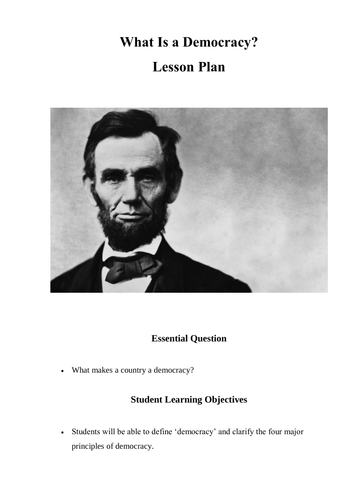

Essential Question
• What makes a country a democracy?
Student Learning Objectives
• Students will be able to define ‘democracy’ and clarify the four major principles of democracy.
• Students will be able to differentiate between direct and representative democracies.
• Students will be able to identify some of the common elements of democracies
• Students will be able to explain to their peers the common principles of democracy and how they are relevant to the United States government.
Strategies
• Warm-Up Free Write: Students work individually on a five-minute free writing assignment based on the following prompt: Write about a time you felt ignored or that your voice was not being heard. What did you do and how did you feel? Students then share their responses with the class. Teacher generates a list of student responses on the board.
• Turn and Talk: Have students work with a partner to discuss why it’s important that every person is given a fair and equal opportunity to have his or her voice heard. help with government job applications Teacher defines democracy for students: A system of government in which all citizens are represented and have equal access to such rights as voting, help with government job applications, education.
• Window Notes: Students work with a partner to complete a window notes graphic organizer (with four window panes) for differentiating between representative democracy and direct democracy. The graphic organizer provides students with a tool for defining and differentiating between representative and direct democracy. The window panes ask students to: define, draw, provide and example, and list the pros/cons of each type of democracy.
• Four R’s of Democracy: Students are placed into four groups. Each group represents a different principle of democracy. The principles, referred to as the “R’s of Democracy” are Rules, Rights, Role, and Respect. Follow the prompts/information below and have students create and present a poster that demonstrates their understanding of the following “R of Democracy.” Posters must include a summary of the principle, how it applies to the U.S. government, two visual representations, and three questions about the principle for the class.
- Majority Rules: In a democratic nation, the will of the majority of voters wins.
- Right to Free and Fair Election: U.S. citizens have the right to vote, and they do not have to pay to do so.
- Roles: A democracy is a government of the people, by the people. Eligible members of society have the right, and responsibility, to vote.
- A. Respect for Human Rights: The U.S. Government must respect the rights of citizens, as defined by the Constitution.
B. Respect for the Law: No society member is above the law, even the President.
• Exit Ticket: Students respond to the following prompt in writing: What are the advantages of living in a democracy?
Something went wrong, please try again later.
This resource hasn't been reviewed yet
To ensure quality for our reviews, only customers who have purchased this resource can review it
Report this resourceto let us know if it violates our terms and conditions.
Our customer service team will review your report and will be in touch.